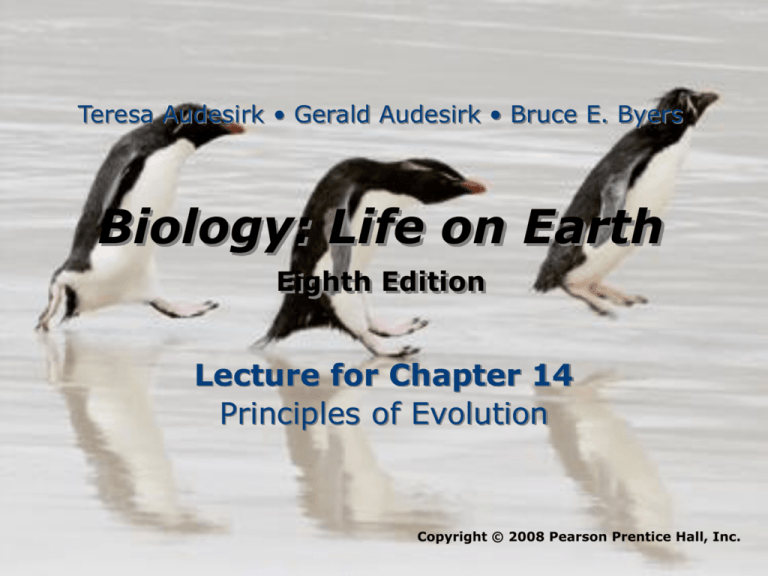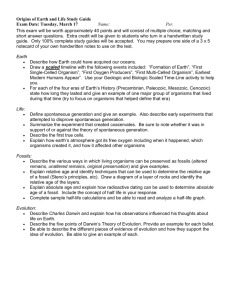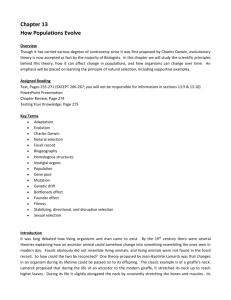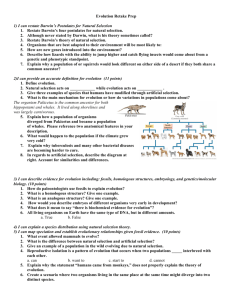
Teresa Audesirk • Gerald Audesirk • Bruce E. Byers
Biology: Life on Earth
Eighth Edition
Lecture for Chapter 14
Principles of Evolution
Copyright © 2008 Pearson Prentice Hall, Inc.
Chapter 14 Outline
• 14.1 How Did Evolutionary Thought Evolve? p.
278
• 14.2 How Do We Know That Evolution Has
Occurred? p. 282
• 14.3 How Does Natural Selection Work? p. 288
• 14.4 What Is The Evidence That Populations
Evolve by Natural Selection? p. 289
Section 14.1 Outline
• 14.1 How Did Evolutionary Thought
Evolve?
– Early Biological Thought Did Not Include the
Concept of Evolution
– Exploration of New Lands Revealed a
Staggering Diversity of Life
– A Few Scientists Speculated That Life Had
Evolved
– Fossil Discoveries Showed That Life Has
Changed Over Time
Section 14.1 Outline (cont.)
– Some Scientists Devised Nonevolutionary
Explanations for Fossils
– Geology Provided Evidence That Earth Is
Exceedingly Old
– Some Pre-Darwinian Biologists Proposed
Mechanisms for Evolution
– Darwin and Wallace Proposed a Mechanism
of Evolution
Evolutionary Thought
• Evolution by natural selection is a unifying
theme for all of biology
• The foundation of evolutionary thought
developed gradually over centuries
• Main ideas of evolution were not widely
accepted until after Charles Darwin
published On the Origin of Species in 1859
Early Biological Thought
• Heavily influenced by theology
– All organisms were created simultaneously
– Each distinct life-form was permanently fixed
and did not change over time
Early Biological Thought
• Expressed by ancient Greek philosophers
– Plato (427-347 B.C.)
– Aristotle (384-322 B.C.) arranged all
organisms on a linear scale of increasing
complexity (“ladder of Nature”)
Exploration of New Lands
(New World)
• Number of species was greater than
expected
• Some species closely resembled one
another
• Some naturalists concluded that similar
species may have developed from a
common ancestor
Speculation That Life Had Evolved
• Comte de Buffon (1707-1788) proposed
that some modern species had evolved
through natural processes
• Idea was not accepted
– Did not provide a mechanism for evolution
– Earth was not old enough to allow time for the
process of evolution
Fossils
• Fossils showed that life had changed over
time
• Fossils are the remains or impressions of
organisms that lived in the past
• Most are found in sedimentary rock
Fossils
• Certain fossils were always found in the
same layers of rock
• Organization of fossils and rock layers was
consistent
• The deeper (older) the layer, the more
dissimilar the fossils from modern
organisms
• Many fossils were of extinct organisms
Nonevolutionary Explanations
• Georges Cuvier (1769-1832) proposed
theory of catastrophism which
hypothesized that
– High numbers of species were created
originally
– A series of catastrophes produced rock layers
and destroyed many species, preserving some
as fossils
– Modern day species are the survivors of these
catastrophies
Earth Is Exceedingly Old
• James Hutton (1726-1797) and Charles
Lyell (1797-1875) studied geologic
processes (wind, water, earthquakes,
volcanism)
• Developed theory of uniformitarianism
(geologic change resulted from slow,
continuous actions similar to those at work
today)
Earth Is Exceedingly Old
• Rock formations reflect repeated cycles of
geologic change occurring over vast
periods of time
• Conclusions:
– Earth was older than the 6,000 years
proposed by theologians
– There was enough time for evolution to occur
Pre-Darwin Proposal
• Jean Baptiste Lamarck (1744-1829)
proposed that organisms evolved through
inheritance of acquired characteristics
– Organisms are modified during their lifetime
through use or disuse of different parts
– These modifications are passed to offspring
Pre-Darwin Proposal
• Inheritance of acquired characteristics
mechanism was rejected when it was
determined that acquired characteristics
are not heritable
Darwin and Wallace
• By mid-1880s the concept of evolution was
increasingly accepted
• 1858 Charles Darwin and Alfred Russel
Wallace independently
– Provided evidence for its occurrence
– Proposed the mechanism through which it
occurs
Darwin and Wallace
• Darwin and Wallace shared experiences
that shaped their thinking
– Aware that fossils showed a trend of
increasing complexity
– Aware of Hutton and Lyell’s proposal that
Earth is extremely old
Darwin and Wallace
• Darwin and Wallace shared experiences,
continued
– Traveled extensively studying tropical plants
and animals
– Observed that similar species differed only in
a few ecologically important features
Darwin and Wallace
• Darwin and Wallace independently
proposed that organisms evolved by
natural selection
• Both presented papers to the Linnaean
Society in London (1858)
• Darwin published On the Origin of
Species by Means of Natural Selection in
1859
Section 14.2 Outline
• 14.2 How Do We Know That Evolution
Has Occurred?
– Fossils Provide Evidence of Evolutionary
Change Over Time
– Comparative Anatomy Gives Evidence of
Descent with Modification
– Embryological Similarity Suggests Common
Ancestry
– Modern Biochemical and Genetic Analyses
Reveal Relatedness Among Diverse
Organisms
Evolution Widely Accepted Today
• Overwhelming body of evidence in
multiple areas of science supports
evolution
Evidence from Fossils
• Fossils of ancient species tend to be
simpler in form than modern species
• Several series of fossils have been found
that exhibit the evolution of body structures
over time
• One series reveals that modern whales
evolved from land-dwelling ancestors
Comparative Anatomy
• Homologous structures provide evidence of
common ancestry
• Homologous structures are structures
that have the same evolutionary origin
despite their current appearance or function
• Bird and mammalian forelimbs are
homologous structures
Comparative Anatomy
• Vestigial structures are remnants of
structures that are inherited from ancestors
– Had important functions in ancestors
– Serve no obvious purpose in present day
organism
• Vestigial structures include:
– Molar teeth in vampire bats
– Pelvic bones in whales and certain snakes
Comparative Anatomy
• Analogous structures are structures that
are outwardly similar in appearance, but
differ in their evolutionary origin
• Analogous structures include
– Wings of insects and birds
– Streamlined shapes of seals and penguins
Comparative Anatomy
• Analogous structures result from
convergent evolution rather than descent
from a common ancestor
• Convergent evolution occurs when similar
environmental pressures and natural
selection give rise to similar (analogous)
structures in distantly related organisms
Embryology
• All vertebrate embryos, resemble one
another in their early development (see
next slide: lemur, pig, human)
• All vertebrate embryos possess genes that
direct development of gill slits and a tail
• It is thought these genes were inherited
from a common ancestor
Embryology
• Adult fish retain gills and tail because the
genes are active throughout their
embryonic development
• Humans are born without gills and a tail
because the genes are active only during
early embryonic development
Biochemistry and Genetics
• All organisms share related biochemical
processes:
– All cells use DNA as genetic blueprint
– All use RNA, ribosomes, and approximately
the same genetic code for translation
– All use roughly the same set of 20 amino acids
to build proteins
– All use ATP to transfer energy
Biochemistry and Genetics
• Striking genetic similarities between
organisms imply evolutionary relatedness
• e.g. the DNA nucleotide sequence of the
human and mouse cytochrome c gene is
very similar, suggesting shared ancestry
Section 14.3 Outline
• 14.3 How Does Natural Selection Work?
– Darwin and Wallace’s Theory Rests on Four
Postulates
– Natural Selection Modifies Populations Over
Time
Evolution by Natural Selection
• Darwin and Wallace proposed that life’s
diverse forms arose through process of
descent with modification
– Individuals in each generation differ slightly
from the members of the preceding
generation
– Over long time periods, small differences
accumulate to produce major transformations
• Proposed process of evolution based on
four postulates regarding populations
Evolution by Natural Selection
• Postulate 1: Individual members of a
population differ from one another in many
respects
– Variations arise purely by chance resulting
from random mutations in DNA
– Differences are obvious in many physical
characteristics and extend to molecular level
Figure 14-12
Variation in a
population of snails
Although these
snails are all
members of the
same population, no
two are exactly alike
Evolution by Natural Selection
• Postulate 2: At least some of the
differences among members of a
population are due to characteristics that
may be passed from parent to offspring
– However, the mechanism of inheritance was
not understood at this point in time
Evolution by Natural Selection
• Postulate 3: In each generation, some
individuals in a population survive and
reproduce successfully but others do not
– Darwin observed that many more individuals
are born than survive
– Some individuals have more offspring than
others
Evolution by Natural Selection
• Postulate 4: Individuals with
advantageous traits survive longest and
leave the most offspring, a process known
as natural selection
Evolution by Natural Selection
• Gregor Mendel’s theories of inheritance
(1865) confirmed Darwin’s assumption
that certain traits are heritable
• New variations arise by chance as a
result of random mutations in DNA
• New variations may be good, bad, or
neutral
Populations Evolve
• Natural selection acts on individuals within
a population; however, it is the population
that changes over time
Section 14.4 Outline
• 14.4 What Is the Evidence That
Populations Evolve by Natural
Selection?
– Controlled Breeding Modifies Organisms
– Evolution by Natural Selection Occurs Today
Controlled Breeding
• Artificial selection is selective breeding to
produce plants and animals that possess
desirable traits
• Modern dogs descended from wolves
• In only a few thousand years, humans
artificially selected for all breeds of modern
dogs
Controlled Breeding
• Humans have created tremendous
variation in several species over relatively
short periods of time through artificial
selection
• Isn’t it plausible that much larger changes
could result from hundreds of millions of
years of natural selection?
Natural Selection Today
• Examples include:
– Coloration in Trinidadian guppies
– Pesticide resistance
– Experimental introductions of Anolis sagrei
lizards
Coloration
• Female guppies prefer to mate with brightly
colored males; however, brightly colored
males are more likely to be eaten by
predators
– Males found in areas lacking predators were
brightly colored
– Males found in areas with predators were duller
by comparison (predators eliminated brightly
colored males before they could reproduce)
Coloration
• Conclusion: When fewer predators are
present, brighter coloration can evolve
• Conclusion was confirmed
– Predators were introduced to previously
predator-free areas (males were brightly
colored)
– Within a few generations male guppies in
those areas evolved to become less colorful
Pesticide Resistance
• Numerous insect pests have evolved
resistance to pesticides
– Roaches developed resistance to Combat®, an
insecticide bait that acted as an agent of
natural selection
– Resistant roaches possessed a rare mutation
that caused them to dislike glucose, the main
attractant in Combat®
• At least one insect species is resistant to
every pesticide in existence
Experiments
• Small groups of Anolis sagrei lizards were
introduced onto 14 small Bahamian islands
with thinly-branched bushes and no trees
– Lizards were originally from Staniel Cay, an
island with thickly-branched trees
– Their long legs were adaptive for maneuvering
in these trees
• The introduced lizards thrived and
reproduced
Experiments
• After 14 years, comparisons were made
between lizards on the Bahamian islands
and those of Staniel Cay
• Lizards on all 14 Bahamian islands had
shorter, thinner legs
Experiments
• Conclusion: Individuals with shorter,
thinner legs evolved because they were
able to escape predators better than their
longer-legged ancestors in the new
environment
Natural Selection of Phenotypes
1. The variations on which natural selection
works are produced by mutations that
arise spontaneously
Natural Selection of Phenotypes
2. Natural selection selects for organisms
that are best adapted to a particular
environment
– If the environment changes, a previously
advantageous trait may become
disadvantageous









